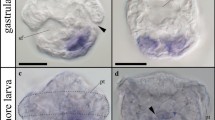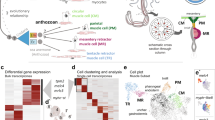Abstract
MRF family genes are found in all animals and play an important role in the development of the muscular system. The study of the available transcriptomes and genomes of different members of Echinodermata showed that they have orthologs of the vertebrate MyoD gene. Crinoids and echinoids have three genes: MyoD1, MyoD2, and MyoD3. Asteroids apparently lost the MyoD3 gene, while holothurians lost MyoD2. In the holothurian Eupentacta fraudatrix, the expression of MyoD3 was significantly increased during muscle regeneration, while the number of MyoD1 transcripts did not change. This may indicate the involvement of MyoD3 in the regulation of myogenesis in holothurians.



Similar content being viewed by others
REFERENCES
Dolmatov, I.Yu. and Mashanov, V.S., Regeneratsiya u goloturii (Regeneration in Holothurians), Vladivostok: Dal’nauka, 2007.
Dolmatov, I.Yu., Bobrovskaya, N.V., and Girich, A.S., Echinoderms as model objects for studying the mechanisms of regeneration, Vestn. S.-Peterb. Univ., Ser. 3, 2014, vol. 3, pp. 96–112.
Adams, M., Celniker, S., Holt R., et al., The genome sequence of Drosophila melanogaster, Science, 2000, vol. 287, no. 5461, pp. 2185–2195.
Andrikou, C., Iovene, E., Rizzo, F., et al., Myogenesis in the sea urchin embryo: The molecular fingerprint of the myoblast precursors, EvoDevo, 2013, vol. 4, 33.
Araki, S., Saiga, H., Makabe, K., and Satoh, N., Expression of AMD 1, a gene for a MyoD 1-related factor in the ascidian Halocynthia roretzi, Roux’s Arch. Dev. Biol., 1994, vol. 203, no. 3, pp. 320–327.
Atchley, W., Fitch, W., and Bronner-Fraser, M., Molecular evolution of the MyoD family of transcription factors, Proc. Natl. Acad. Sci. U. S. A., 1994, vol. 91, no. 24, pp. 11522–11526.
Balagopalan, L., Keller, C., and Abmayr, S., Loss-of-function mutations reveal that the Drosophila nautilus gene is not essential for embryonic myogenesis or viability, Dev. Biol., 2001, vol. 231, no. 2, pp. 374–382.
Baugh, L. and Hunter, C., MyoD, modularity, and myogenesis: Conservation of regulators and redundancy in C. elegans, Genes Dev., 2006, vol. 20, pp. 3342–3346.
Bergstrom, D. and Tapscott, S., Molecular distinction between specification and differentiation in the myogenic basic helix-loop-helix transcription factor family, Mol. Cell. Biol., 2001, vol. 21, no. 7, pp. 2404–2412.
Boyko, A., Girich, A., Tkacheva, E., and Dolmatov, I., The Eupentacta fraudatrix transcriptome provides insights into regulation of cell transdifferentiation, Sci. Rep., 2020, vol. 10, 1522.
Buckingham, M. and Rigby, P., Gene regulatory networks and transcriptional mechanisms that control myogenesis, Dev. Cell, 2014, vol. 28, no. 3, pp. 225–238.
Candia Carnevali, M.D., Regeneration in Echinoderms: Repair, regrowth, cloning, Invertebr. Survival J., 2006, vol. 3, no. 1, pp. 64–76.
Conerly, M., Yao, Z., Zhong, J., et al., Distinct activities of Myf5 and MyoD indicate separate roles in skeletal muscle lineage specification and differentiation, Dev. Cell, 2016, vol. 36, no. 4, pp. 375–385.
Dehal, P., Satou, Y., Campbell, R., et al., The draft genome of Ciona intestinalis: Insights into chordate and vertebrate origins, Science, 2003, vol. 298, no. 5601, pp. 2157–2167.
Dolmatov, I., Development and evolution of the muscle system in the Echinodermata, in Echinoderms: Proc. 12th Int. Echinoderm Conf., Durham, U. S. A., 2010, pp. 163–166.
Dolmatov, I., Afanasyev, S., and Boyko, A., Molecular mechanisms of fission in echinoderms: Transcriptome analysis, PLoS One, 2018, vol. 13, no. 4, e0195836.
Dolmatov, I., Eliseikina, M., Bulgakov, T., et al., Muscle regeneration in the holothurian Stichopus japonicus, Roux’s Arch. Dev. Biol., 1996, vol. 205, pp. 486–493.
Dolmatov, I. and Ginanova, T., Muscle regeneration in holothurians, Microsc. Res., 2001, vol. 55, no. 6, pp. 452–463.
Dolmatov, I. and Ivantey, V., Histogenesis of longitudinal muscle bands in holothurians, RJDB, 1993, vol. 24, pp. 67–72.
Fukushige, T., Brodigan, T., Schriefer, L., et al., Defining the transcriptional redundancy of early bodywall muscle development in C. elegans: Evidence for a unified theory of animal muscle development, Genes Dev., 2007, vol. 20, pp. 3395–3406.
Garcia-Arraras, J. and Dolmatov, I., Echinoderms: Potential model systems for studies on muscle regeneration, Curr. Pharm. Des., 2010, vol. 16, no. 8, pp. 942–955.
Garcia-Arraras, J., Estrada-Rodgers, L., Santiago, R., et al., Cellular mechanisms of intestine regeneration in the sea cucumber, Holothuria glaberrima Selenka (Holothuroidea: Echinodermata), J. Exp. Zool., 1998, vol. 281, pp. 288–304.
Ginanova, T., DNA synthesis during muscle regeneration in sea cucumber, Biol. Bull., 1998, vol. 25, pp. 9–13.
Grounds, M., Garrett, K., Lai, M., et al., Identification of skeletal muscle precursor cells in vivo by use of MyoD1 and myogenin probes, Cell Tissue Res., 1992, vol. 267, pp. 99–104.
Guindon, S., Dufayard, J., Lefort, V., et al., New algorithms and methods to estimate maximum-likelihood phylogenies: Assessing the performance of PhyML 3.0, Syst. Biol., 2010, vol. 59, no. 3, pp. 307–321.
Howard-Ashby, M., Materna, S., Brown, C., et al., Gene families encoding transcription factors expressed in early development of Strongylocentrotus purpuratus, Dev. Biol., 2006, vol. 300, no. 1, pp. 90–107.
Ishibashi, J., Perry, R., Asakura, A., and Rudnicki, M., MyoD induces myogenic differentiation through cooperation of its NH2- and COOH-terminal regions, J. Cell Biol., 2005, vol. 171, no. 3, pp. 471–482.
Karalaki, M., Fili, S., Philippou, A., and Kontsilieris, M., Muscle regeneration: Cellular and molecular events, In Vivo, 2009, vol. 23, pp. 779–796.
Lanfear, R., Frandsen, P., Wright, A., et al., PartitionFinder 2: New methods for selecting partitioned models of evolution for molecular and morphological phylogenetic analyses, Mol. Biol. Evol., 2016, vol. 34, no. 3, pp. 772–773.
Lassar, A., Davis, R., Wright, W., et al., Functional activity of myogenic HLH proteins requires hetero-oligomerization with E12/E47-like proteins in vivo, Cell, 1991, vol. 66, no. 2, pp. 305–315.
Mashanov, V., Dolmatov, I., and Heinzeller, T., Transdifferentiation in holothurian gut regeneration, Biol. Bull., 2005, vol. 209, no. 3, pp. 184–193.
Mashanov, V., Zueva, O., and Heinzeller, T., Regeneration of the radial nerve cord in a holothurian: A promising new model system for studying post-traumatic recovery in the adult nervous system, Tissue Cell, 2008, vol. 40, no. 5, pp. 351–372.
Michelson, A., Abmayr, S., Bate, M., et al., Expression of a MyoD family member prefigures muscle pattern in Drosophila embryos, Genes Dev., 1990, vol. 4, pp. 2086–2097.
Mladenov, P., Igdoura, S., Asotra, S., et al., Purification and partial characterization of an autotomy-promoting factor from the sea star Pycnopodia helianthoides, Biol. Bull., 1989, vol. 176, no. 2, pp. 169–175.
Pavlath, G., Dominov, J., Kegley, K., et al., Regeneration of transgenic skeletal muscles with altered timing of expression of the basic helix-loop-helix muscle regulatory factor MRF4, Am. J. Pathol., 2003, vol. 162, no. 5, pp. 1685–1691.
Ronquist, F., Teslenko, M., van der Mark, P., et al., MrBayes 3.2: Efficient Bayesian phylogenetic inference and model choice across a large model space, Syst. Biol., 2012, vol. 61, no. 3, pp. 539–542.
Rudnicki, M., Braun, T., Hinuma, S., and Jaenisch, R., Inactivation of MyoD in mice leads to up-regulation of the myogenic HLH gene Myf-5 and results in apparently normal muscle development, Cell, 1992, vol. 71, no. 3, pp. 383–390.
Rudnicki, M., Schnegelsberg, P., Stead, R., et al., MyoD or Myf-5 is required for the formation of skeletal muscle, Cell, 1993, vol. 75, no. 7, pp. 1351–1359.
Singh, K. and Dilworth, F., Differential modulation of cell cycle progression distinguishes members of the myogenic regulatory factor family of transcription factors, FEBS J., 2013, vol. 280, no. 17, pp. 3991–4003.
Van Doren, M., Ellis, H., and Posakony, J., The Drosophila extramacrochaetae protein antagonizes sequence-specific DNA binding by daughterless achaete-scute protein complexes, Development, 1991, vol. 113, no. 1, pp. 245–255.
Van Doren, M., Powell, P., Pasternak, D., et al., Spatial regulation of proneural gene activity: Auto- and cross-activation of achaete is antagonized by extramacrochaetae, Genes Dev., 1992, vol. 6, pp. 2592–2605.
Venuti, J., Goldberg, L., Chakraborty, T., et al., A myogenic factor from sea urchin embryos capable of programming muscle differentiation in mammalian cells, Proc. Natl. Acad. Sci. U. S. A., 1991, vol. 88, no. 14, pp. 6219–6223.
Weintraub, H., Dwarki, V., Verma, I., et al., Muscle-specific transcriptional activation by MyoD, Genes Dev., 1991, vol. 5, no. 8, pp. 1377–1386.
White, J., Scaffidi, A., Davies, M., et al., Myotube formation is delayed but not prevented in myoD-deficient skeletal muscle: Studies in regenerating whole muscle grafts of adult mice, J. Histochem. Cytochem., 2016, vol. 48, no. 11, pp. 1531–1544.
Zhou, Z. and Bornemann, A., MRF4 protein expression in regenerating rat muscle, J. Muscle Res. Cell Motil., 2001, vol. 22, pp. 311–316.
ACKNOWLEDGMENTS
The authors are grateful to A.S. Girich and A.V. Boyko for help in research.
Funding
This work was supported by the Russian Science Foundation (grant no. 21-74-30004).
Author information
Authors and Affiliations
Corresponding author
Ethics declarations
Conflict of interest. The authors declare that they have no conflicts of interest.
Statement on the welfare of animals. All applicable international, national, and/or institutional guidelines for the care and use of animals were followed.
Additional information
Translated by T. Koznova
Rights and permissions
About this article
Cite this article
Nizhnichenko, V.A., Dolmatov, I.Y. Gene Orthologs of Myogenic Regulatory Factors (MRF) Family and their Possible Functions in Echinoderms. Russ J Mar Biol 48, 185–194 (2022). https://doi.org/10.1134/S1063074022030063
Received:
Revised:
Accepted:
Published:
Issue Date:
DOI: https://doi.org/10.1134/S1063074022030063




